
Kobe Bryant is turning the final page of what can only be described as a storybook career. Once a high school phenom, Bryant embraced a role as Hollywood’s leading man, becoming one of his sport’s greatest competitors and cemented a legacy as the rightful heir apparent. All good things must come to an end, but true greatness endures. As Kobe prepares to exit the stage, here’s an illustrated look at the defining moments of his remarkable tenure in Los Angeles.

1. Chapter 1: The Arrival (‘97 Dunk Contest)
Bryant oozed charisma from the moment he announced his decision to forego college in his high school gym with a pair of sunglasses perched on top of his head. The glitz and glamour of playing in Hollywood never seemed to be too big for him. Even though it took him a few years to crack the Lakers’ starting lineup, he displayed star-level ability from the jump.
As a rookie, Bryant’s “arrival” took place during All-Star Weekend, where all eyes were on him and what he had planned for his highly anticipated Slam Dunk Contest performance. The legend of Bryant’s athletic ability and dunk prowess had spread from his days in high school — now he had the national stage to showcase exactly what he had in his arsenal.
Laced up in the adidas EQT Elevation, Bryant started the contest by dunking in his Lakers shooting shirt, which spoke to his understanding of showmanship at a young age. In his mind, advancing beyond the first round was a given, so he treated the first few dunks like a warmup — if variations of reverse dunks could be considered as such. Bryant’s swagger, gait and gazes into the crowd were all traits of a young man who had no plans of losing.
What many forget is that Bryant’s nonchalant approach almost cost him a spot in the final. He qualified as the third and last competitor in the field behind Chris Carr and Michael Finley, barely edging past Darvin Ham. But it was almost as if he had purposely orchestrated a dramatic finish to his crowning.
The first dunker in the finals, Bryant opens with a between-the-legs windmill, followed by the competitive scowl that would become a familiar sight over the next 20 seasons. Judges awarded the dunk a score of 49, which may have been a point too low, but was still enough to clinch Bryant’s first trophy as a pro.
Without overstating things, the ’97 Dunk Contest was our first glimpse of Bryant’s championship DNA. He had a flair for the dramatic, unmatched competitive drive and an unbridled will to win, and somehow showed it all with a handful of exhibition dunks in Cleveland that weekend. It also happened during a time when winning a dunk contest carried a little more prestige than it does today, and facing that challenge, Bryant did as greats like Erving and Jordan did before him — he saved his best for last, and came up big when it mattered most.
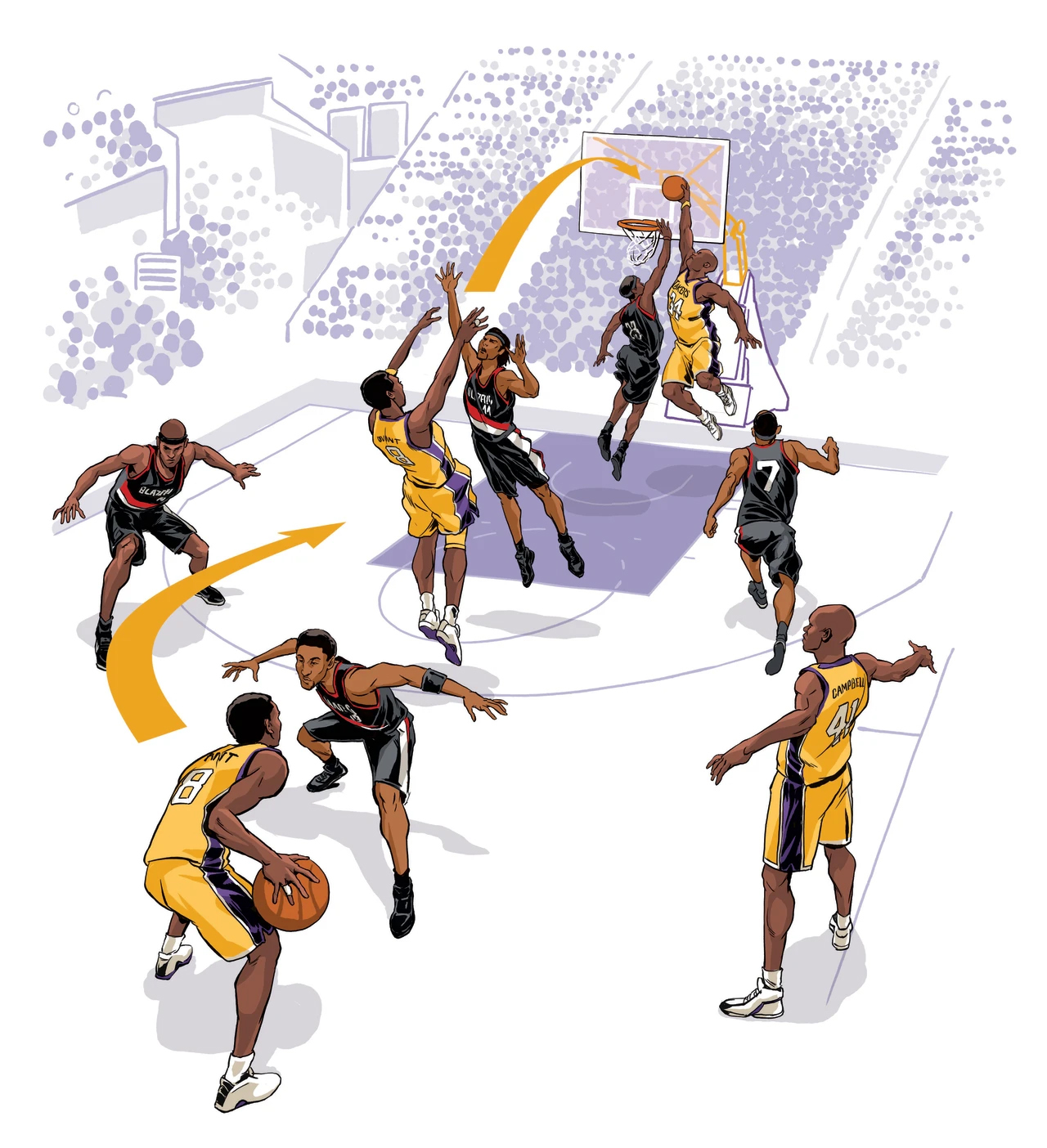
2. Chapter 2: A Champion is Born (Kobe-to-Shaq Alley Oop)
A duo mostly known for being dysfunctional, Bryant and Shaquille O’Neal sparked the Lakers’ three-peat at the beginning of the millennium with one of the most memorable displays of teamwork in NBA history.
The Lakers had blown a 3-1 series lead and were trailing the Portland Trail Blazers 75-60 in the 4th quarter of Game 7 of the 2000 Western Conference Finals. With a loss, they would have become just the seventh team to lose a series after leading 3-1. What could have been an epic meltdown turned into a comeback for the ages.
As the Blazers went cold from the field, the Lakers rolled off a 15-0 run to draw even. The teams then traded baskets before Bryant and O’Neal helped the Lakers seize control of the game. After being held in check for most of the night, O’Neal scored nine points in the 4th quarter, the last two the result of arguably the defining moment of the Lakers’ 2000s dynasty.
Up by four with less than a minute left to play, Bryant, wearing the adidas The Kobe, controlled the ball at the top of the key, where he was able to shake Scottie Pippen with a crossover dribble and penetrate the lane. As the defense collapsed on him in the paint, Bryant lobbed the ball to a wide open O’Neal, who hammered home a one handed dunk to punctuate the historic rally. The Big Fella famously ran back down the court with his index fingers in the air before finding Bryant for a high five in the huddle as the Staples Center crowd roared.
The alley-oop wasn’t the game-winner or even the go ahead bucket, but it was the moment when everyone knew that the Lakers weren’t going to be denied. Following the biggest comeback ever in a Game 7, they went on to win the game and advanced to the NBA Finals, where they defeated the Indiana Pacers to claim the storied franchise’s first championship since 1988.
While Shaq’s celebration following the alley-oop will always be the lasting image from Game 7, it should also be remembered as Bryant’s arrival as an all-time clutch playoff performer. He led the Lakers in scoring, rebounding, assists, and blocks in the game, and made several key plays down the stretch. Much has been made of the Bryant vs. O’Neal rivalry that eventually led to the tandem’s split in 2004. But when they were on the same page, even facing seemingly insurmountable odds, they were nearly unstoppable.
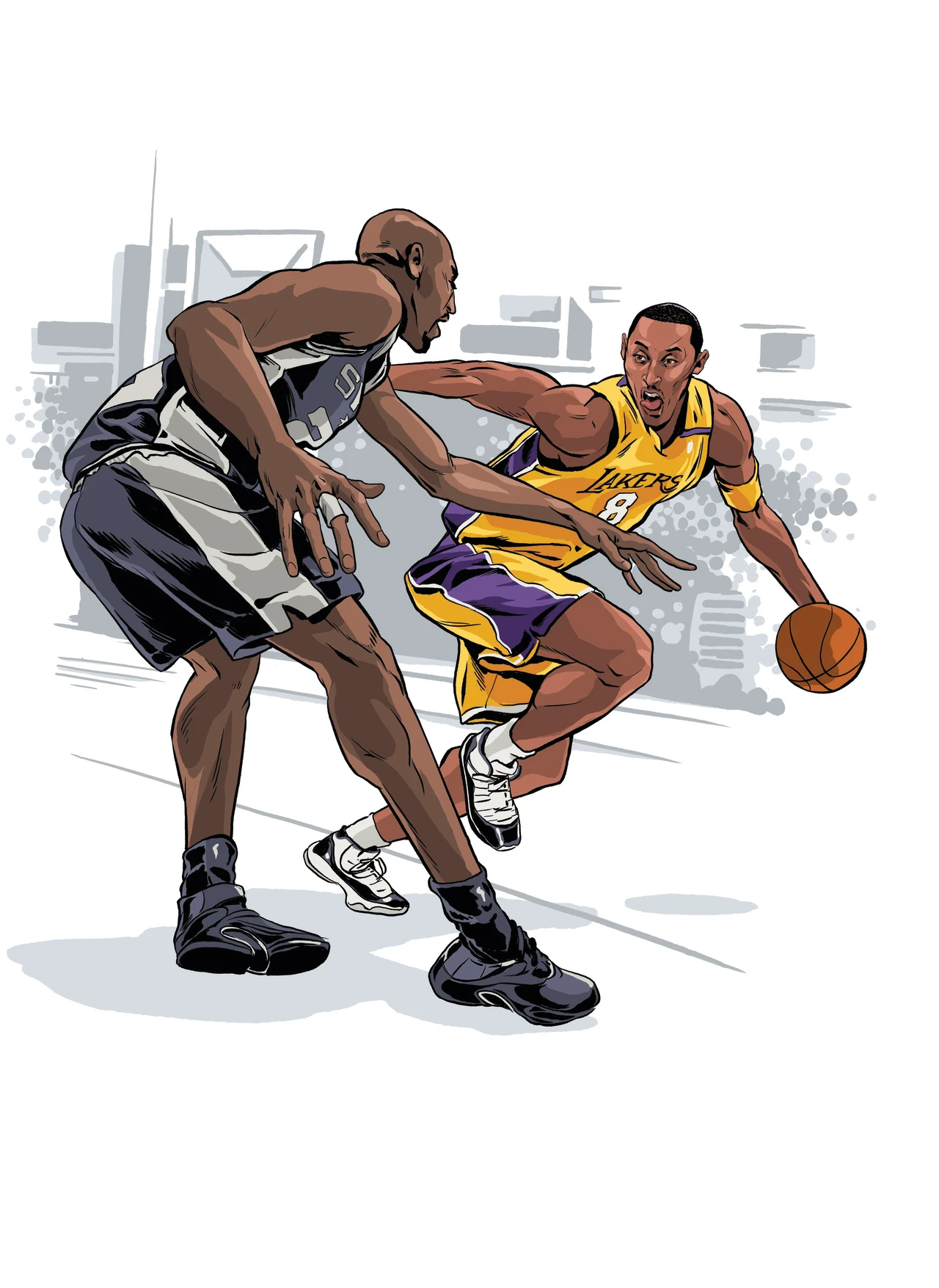
3. Chapter 3: Tough Decisions (Sneaker Free Agency)
Displeased with the direction of his signature sneaker line, Kobe Bryant paid a reported $8 million to buy out his contract with adidas in 2002, after spending his first six years in the league with the brand. The buyout included a stipulation that restricted Bryant from signing for a year, meaning that one of the world’s best would have to play the 2002-03 season without a sneaker endorsement deal.
What could have been a hit to his marketability turned into the most intriguing season of footwear ever worn by a single player. Bryant couldn’t put ink to paper, but just about every company showed interest in acquiring his services for the following season and made sure he had the opportunity to try the sneakers they had to offer on-court.
In a surprisingly modest effort to woo Bryant, Nike supplied him with his own Player Exclusive colorways of classic models like the Air Force 1 and Air Flight Huarache. Reebok made a play by sending him custom versions of shoes from Allen Iverson’s signature line. Converse served up the classic Weapon made famous by former Laker Magic Johnson. Even streetball brand AND1 took a shot with a few pairs from its limited range. Watching to see which sneakers Bryant would break out next became an event in itself.
Perhaps making the biggest splash during Bryant’s sneaker free agency was Jordan Brand. Throughout the season, he was laced up in the brand’s best releases, in addition to Lakers-Inspired Air Jordan 3, Air Jordan 7, Air Jordan 8 and Air Jordan 9 exclusives. With Michael Jordan playing his final season in Washington, his brand was in need of a worthy successor, and Bryant would have done a more than adequate job filling his idol’s shoes.
During the summer of 2003, Bryant signed a four-year endorsement deal with Nike, beginning a partnership that would spawn one of the all-time great signature sneaker lines and help transform him into a global icon. However, his season of sneaker free agency is something that will never be forgotten. Without a deal, Bryant still found a way to impact the landscape of the sneaker industry, inspiring similar unpredictable sneaker rotations for players like Gilbert Arenas, Nate Robinson, and Nick Young in later years. With endorsements becoming increasingly important for sneaker brands, it'll be a while before a player of his caliber plays without a deal again.

4. Chapter 4: An Epic Performance (Scores 81 Points in a Game)
Because of time and archaic technology, most people have heard of Wilt Chamberlain’s 100-point game, but have never seen it. The image of Chamberlain holding up a piece of paper scribbled with his awe-inspiring point total is the lone piece of evidence that the legendary performance ever occurred. As a result, a player being in that kind of zone as a scorer always seemed unthinkable — until January 23, 2006.
There wasn’t much of a reason to be intrigued by a matchup between the 14-26 Toronto Raptors and 21-19 Los Angeles Lakers on that day, other than having an opportunity to watch Bryant perform. He was in the midst of the best scoring season of his career and one of the best in league history. A barrage of points was to be expected, but Bryant took his game to a level unseen in this era.
Bryant scored 26 points in the first half, which makes what happened on this day even more impressive. Not that 26 is anything to scoff at — showing up to a game in which Kobe may threaten 50 is a spectator’s dream. However, the Lakers trailed the Raptors by 14 points at halftime and Bryant knew he had to turn up the intensity.
The Raptors pushed their lead to 18 in the third quarter before the Mamba took control. Using his perimeter shooting, Bryant tallied 27 third-quarter points, helping the Lakers not only erase their deficit, but carry a 6-point lead of their own into the fourth quarter. His 53 points at the end of three would have been good for the second-highest point total of the season, but there was still work to do.
As the Raptors hung around in the fourth quarter, the Lakers’ strategy was clear; get the ball to Kobe and let him go to work. Mixing it up from the outside and in the paint, Bryant slowly hit different scoring milestones on his way to NBA immortality. Connecting on a deep jumper with a little more than four minutes to play, Bryant pushed his total to 72, surpassing Elgin Baylor’s franchise record. He added another jumper before knocking down seven-straight free throws for 28 fourth-quarter points and 81 overall.
Understanding that his star player deserved recognition for what he had accomplished, Phil Jackson subbed Bryant out with a few seconds left to play. He left the Staples Center floor with his taped right index finger in the air and Nike Zoom Kobe 1 on-foot — possibly the defining image of his career.
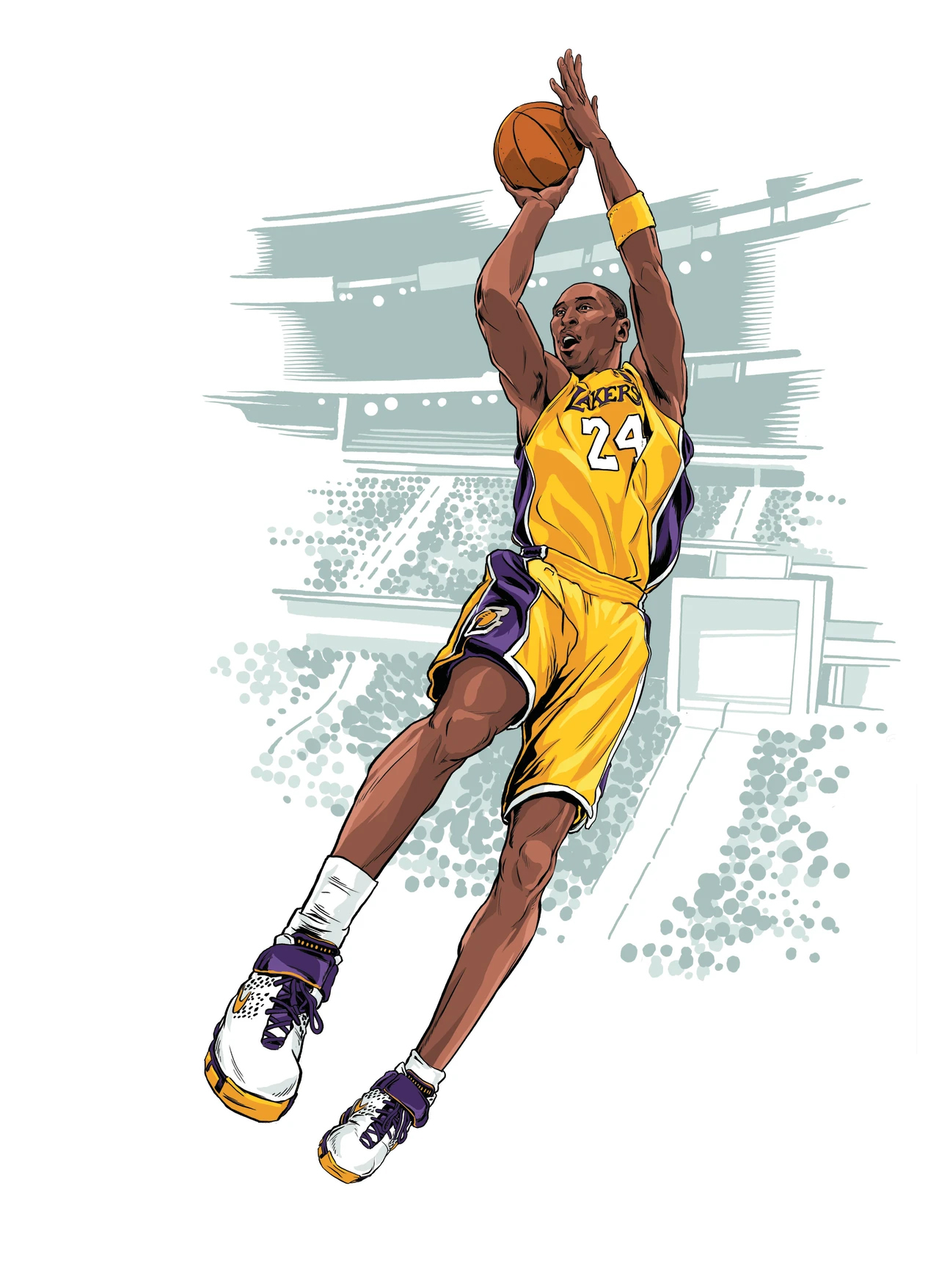
5. Chapter 5: Domination of the Game (Four Straight 50-Point Games)
Having lost their last 7 games and teetering just over .500 with a 33-32 record, the Los Angeles Lakers’ 2006-2007 season was heading in the wrong direction when Bryant put together one of the great strings of high-scoring games in NBA history.
It started at home against the Portland Trail Blazers on March 16, 2007, often described as one of the best games Bryant ever played. At work in the Nike Zoom Kobe 2, he knocked down contested shot after contested shot, racking up 65 points while his old rivals threw everything they had at him defensively. One defender? Good luck. Two? Still not enough. Bryant scored 24 points in the fourth quarter and hit three consecutive three-point shots down the stretch of regulation to help the Lakers erase a 7-point deficit, eventually sending the game to overtime. He added nine in the extra frame to lead the Lakers to victory and back into the win column.
The streak, which it wasn’t known as at that point, continued against the Minnesota Timberwolves two days later. There was a little less drama in this one, though the Wolves did battle back from 19 points down in the fourth quarter. However, Kobe’s 12 in the period sealed a victory and gave him and even 50 for the game.
One of the most important factors in Bryant’s 50-point stretch is that the Lakers needed every one of his performances to win. With the Memphis Grizzlies on the road next on the schedule, Bryant poured in another 60 points. The barrage proved to be just enough, as the Lakers staved off a Memphis surge at the end to win their third straight. Bryant became the first player since Michael Jordan in 1986-87 to score 50+ in three consecutive games.
The fourth and final game of the streak took place at New Orleans Arena, where the Lakers squared off against the New Orleans/Oklahoma City Hornets in another nail-biter. With the rest of the Lakers struggling to make an impact, Kobe willed his team to victory with an efficient 50 points.
The streak ended after Bryant only scored 43 points in the next game against the Golden State Warriors. Only Wilt Chamberlain (7) had a longer stretch of 50-point games than Bryant's four. During the streak, Bryant connected on 76 of 140 overall field goal attempts, good for 54 percent shooting. More importantly, he guided the Lakers over a midseason wall and to another postseason appearance.
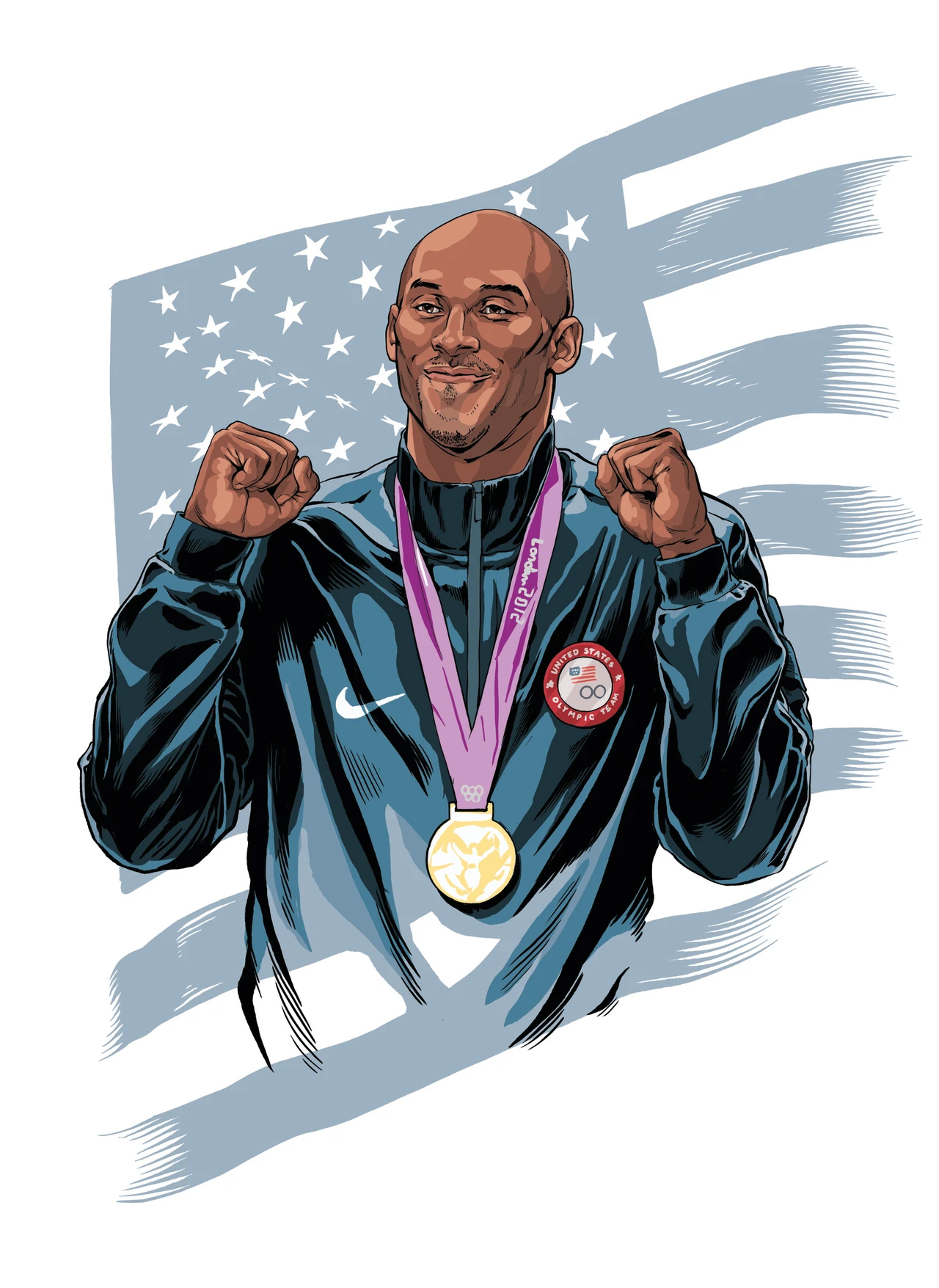
6. Chapter 6: For Love of Country (Wins Olympic Gold Medal)
A disappointing bronze medal finish in the 2004 Olympics and waning interest from American pros left the USA Basketball program in need of an overhaul heading into the Beijing qualifiers. The first move was appointing basketball guru Jerry Colangelo to the newly created position of Managing Director of the USA Basketball Men’s Senior National Team in 2005. Then, Duke University’s Mike Krzyzewski was named the team’s head coach. Together, Colangelo and Coach K assembled a program of players who would compete as part of the cycle leading into the Olympics.
Named the “Redeem Team,” a spin on the 1992 “Dream Team,” the 2008 Olympic team set forth to restore the United States’ dominance in the sport. The program hadn’t won a gold medal in any form of international competition since 2000, a fact that no longer sat well with the world's best players.
With younger stars like LeBron James, Carmelo Anthony and Dwyane Wade still maturing, the USA brass knew they were in need of a leader. After missing the 2006 FIBA World Championships due to minor knee surgery, Kobe Bryant was not only named to the 2008 U.S. Olympic Basketball Team, but was chosen as its captain in what would be his first taste of Olympic competition.
With being the lead for Nike’s newly introduced Hyperdunk sneaker added to his portfolio, Bryant’s trip to China for the summer games showcased just how big of an international star he had become. He drew mobs of fans at any venue he attended, even rivaling the reception given to countryman Yao Ming. Chinese fans appreciate elite talent, but it was Bryant’s championship pedigree that truly drew their admiration.
Though he was the face of the team, Bryant was willing to share the spotlight with his talented comrades. He didn’t lead the team in any major statistical category, but when USA needed clutch buckets, Bryant’s number was called. That was never more evident than in the gold medal final against his Laker teammate Pau Gasol and the team from Spain, the 2006 FIBA World Champions.
Team USA’s first real test of the tournament, Spain kept the game close and even nudged within 2 points in the fourth quarter. However, it was Bryant’s time to shine, and after early foul trouble disputed his start, he closed in grand fashion. Bryant scored 13 of his 20 points in the fourth and handed out two of his game high six assists. Anytime Spain put together a run, it was Bryant who made a momentum-stealing play. Buying into his methods, Bryant teammates could even be seen performing his signature scowl and fist pumps down the stretch. Team USA held Spain for Olympic gold on the back of Bryant, recapturing the program’s glory and setting a new standard for what it means to represent the United States on a global platform.
Bryant helped Team USA repeat as Olympic champions four years later in London.

7. Chapter 7: Finally (Wins MVP)
For the first and only time in his career, Bryant was named the winner of the 2007-08 Maurice Podoloff Trophy, recognizing the NBA’s Most Valuable Player.
In the mid-2000s, the Los Angeles Lakers were a depleted team in search of the right mix of talent to put around their superstar shooting guard. Their vision finally took shape during the 07-08 season, primarily after they were able to swing a trade for big man Pau Gasol. With help in the fold, the Lakers were not only a much better team than they had been in previous years, but Bryant finally had the pieces he needed to play at his highest level as an individual.
After winning just 42 games the previous season, Bryant led the Lakers to a record of 57-25, a 15-game improvement and the best in the Western Conference. Additionally, they won the Pacific Division for the first time in four years, the franchise’s 19th division title overall.
Racking up honors in the Nike Zoom Kobe III, Bryant was the season’s only unanimous selection for the All-NBA team, the sixth nod of his career. He also headlined the All-Defensive First Team, his eighth overall selection. Three times he was named the Western Conference Player of the Week and took home Western Conference Player of the Month honors twice. On the milestone front, Bryant became the youngest player in league history to score 20,000 career points and the 16th to reach 21,000 points and 4,000 assists. He passed 12 players on the all-time scoring list, including four Hall of Famers, to move to 24th.
What’s often forgotten about Bryant’s MVP season is that he played a portion of it with a serious ligament injury to his shooting hand. Instead of getting the advised surgery, he delayed any procedure until he saw things through with a team he felt was special. The decision proved to be the right one, as the Lakers stormed through the Western Conference playoffs and made their first trip to the NBA Finals since 2004. They didn’t win the championship, but it was a necessary building block for future achievements and they surely wouldn't have made it if Bryant were on the bench wearing a cast.
Bryant should have been awarded more MVPs before he called it quits, but he was particularly deserving for his performance and overall growth in 07-08. He laid it all on the line for the Lakers, and because of that, he was invaluable to their success.

8. Chapter 8: Far From Over (4th Championship)
After the Boston Celtics defeated the Los Angeles Lakers in the 2008 NBA Finals, Bryant felt the pressure of trying to win his first championship in the post-Shaquille O’Neal Laker era. His critics were louder than ever, but confidence never wavered as his team embarked on redemption.
The Lakers posted a 65-17 record during the 2008-09 season, their best since 2000. They entered the postseason as the Western Conference’s top seed, meaning the road to the NBA Finals ran through Staples Center. The path featured playoff rematches from the previous season against the Denver Nuggets and Utah Jazz, which the Lakers handled with relative ease. In between, arguably their toughest series of the postseason, a 7-gamer with the Houston Rockets, won with a stifling defensive effort in Game 7.
While many predicted a rematch against the Celtics or a date with LeBron James’ Cleveland Cavaliers, it was the versatile Orlando Magic who emerged as Eastern Conference champions. The team floored arguably the league’s best center in Dwight Howard, along with a wealth of perimeter shooters that foreshadowed the stretch offenses that would become more prevalent around the league in later years.
But the Lakers had Bryant, and he wasn’t to be denied this time around. He set the tone from the jump, hanging 40 points on the Magic in a Game 1 blowout. The 29 he posted in Game 2 were his lowest point total of the Finals, but still good enough to help the Lakers gain a 2-0 advantage. The Magic were unable to find an answer for Bryant in the games that would follow, giving up a series average of 32 points to him alone. He also hurt the Magic with his passing, recording 8 assists in four of five series games.
After his clutch shots in overtime of Game 4 helped the Lakers take a commanding 3-1 lead. A fourth title was in sight for Bryant. The next game took place in Orlando, and the Lakers had no plans of going back home empty handed. Decisive advantages in the second and third quarters of Game 5 gave the Lakers an insurmountable lead — one they wouldn’t relinquish en route to winning the NBA championship.
As the buzzer sounded, Bryant jumped up repeatedly pumping his fist, a champion once again. For his efforts, he was also named Finals MVP for the first time in his career. A championship is a team accomplishment, but this was a personal journey for Bryant, who fittingly captured ring number four in the Nike Zoom Kobe 4. With this victory, he was validated as a leader and an all-time great.
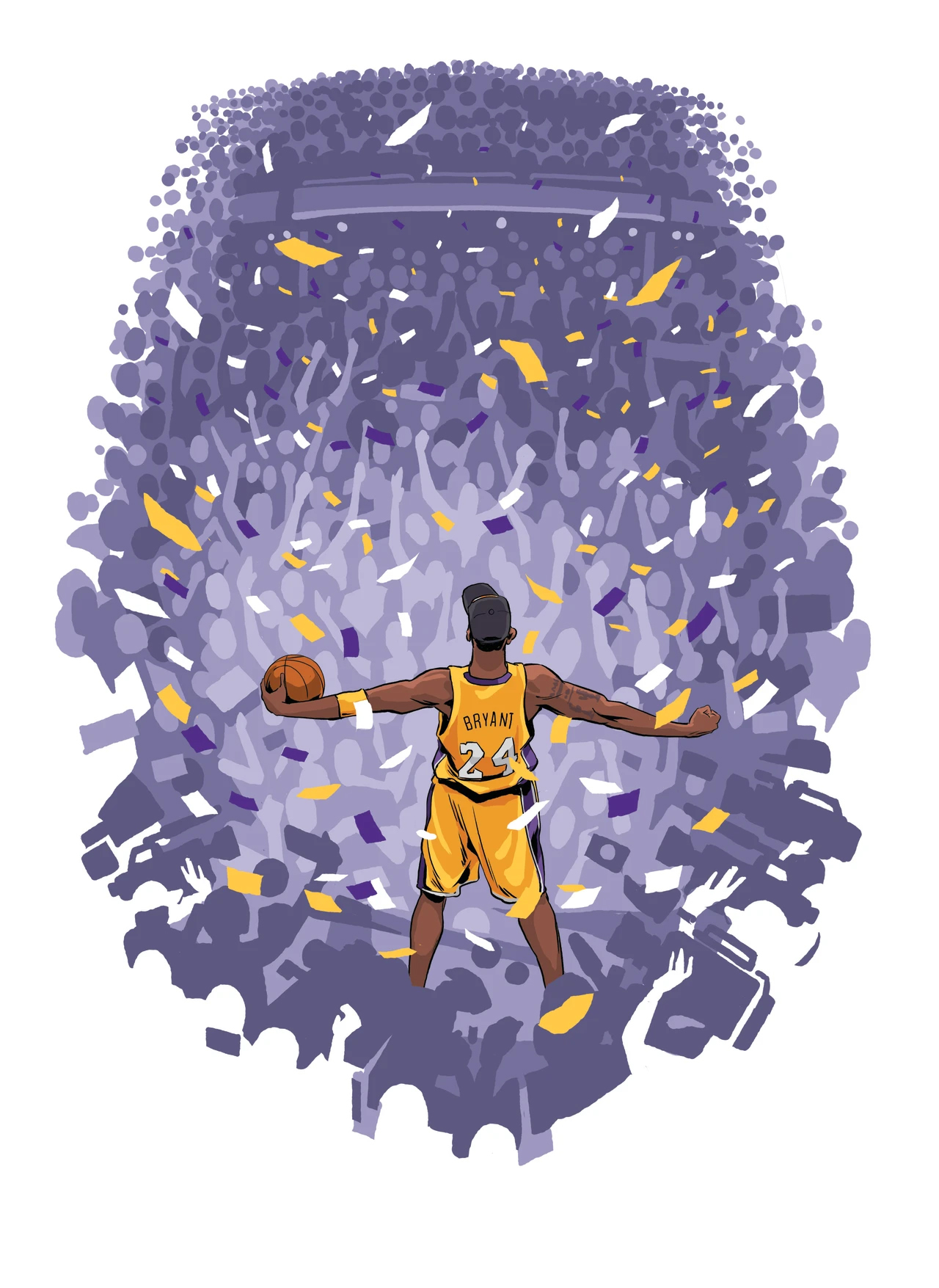
9. Chapter 9: Back to Back (Fifth Championship)
The mark of any good team is a championship. The mark of a great team in winning back-to-back. Fresh off his first ring since 2002, Bryant was able to play the 2009-10 season free of the stigma of not being able to win as the undisputed leader of his team. Now the goal was to establish his Lakers as something more than a one-and-done winner, as he had alongside Shaq earlier in the decade.
Bryant had earned a reputation for being a clutch player early in his career, but his 09-10 season was his most resilient yet. He hit a total of six game-winning shots, including three at the buzzer.
There were roadblocks for the Lakers, though, primarily in the form of mounting injuries. Bryant himself dealt with another injury to his shooting hand, this time a fractured index finger. Because of time missed by various players, most notably Bryant, the Lakers won eight less games than they did the prior season. Still, their 57-25 record was good for another Pacific Division title and the top seed in the Western Conference.
For the Lakers, the playoffs opened with a fresh matchup against the upstart Oklahoma City Thunder. The tandem of Kevin Durant and Russell Westbrook were a handful, but the Lakers were a little too seasoned for the youngsters. Then, series against familiar foes in the Utah Jazz and Phoenix Suns, both won handily by the defending champs.
Waiting for the Lakers in the Finals were the Boston Celtics, the franchise’s most hated rival and the same team that had beaten them in the NBA Finals two years earlier. Bryant, who had been haunted by the earlier Finals defeat, looked to avenge the loss and leave his own mark on the league’s most storied rivalry.
The series went seven games, as a Lakers vs. Celtics Finals should. Boston played for the title with a 3-2 lead, but the Lakers staved off elimination with a gritty defensive effort in Game 6. For Game 7, Hollywood was the right setting for a storybook ending. The Lakers trailed by as much as 13 in the second half, but battled back to tie the game early in the 4th quarter. Bryant scored 10 of his game-high 23 points in the final frame to help the Lakers pull away late, successfully defending their championship.
On the big stage, as his Finals Nike Zoom Kobe V sneakers were nicknamed, Bryant walked away with his second-straight Finals MVP and a fistful of rings. The fourth championship got him over the hump — the fifth cemented him as a pillar of Laker basketball.
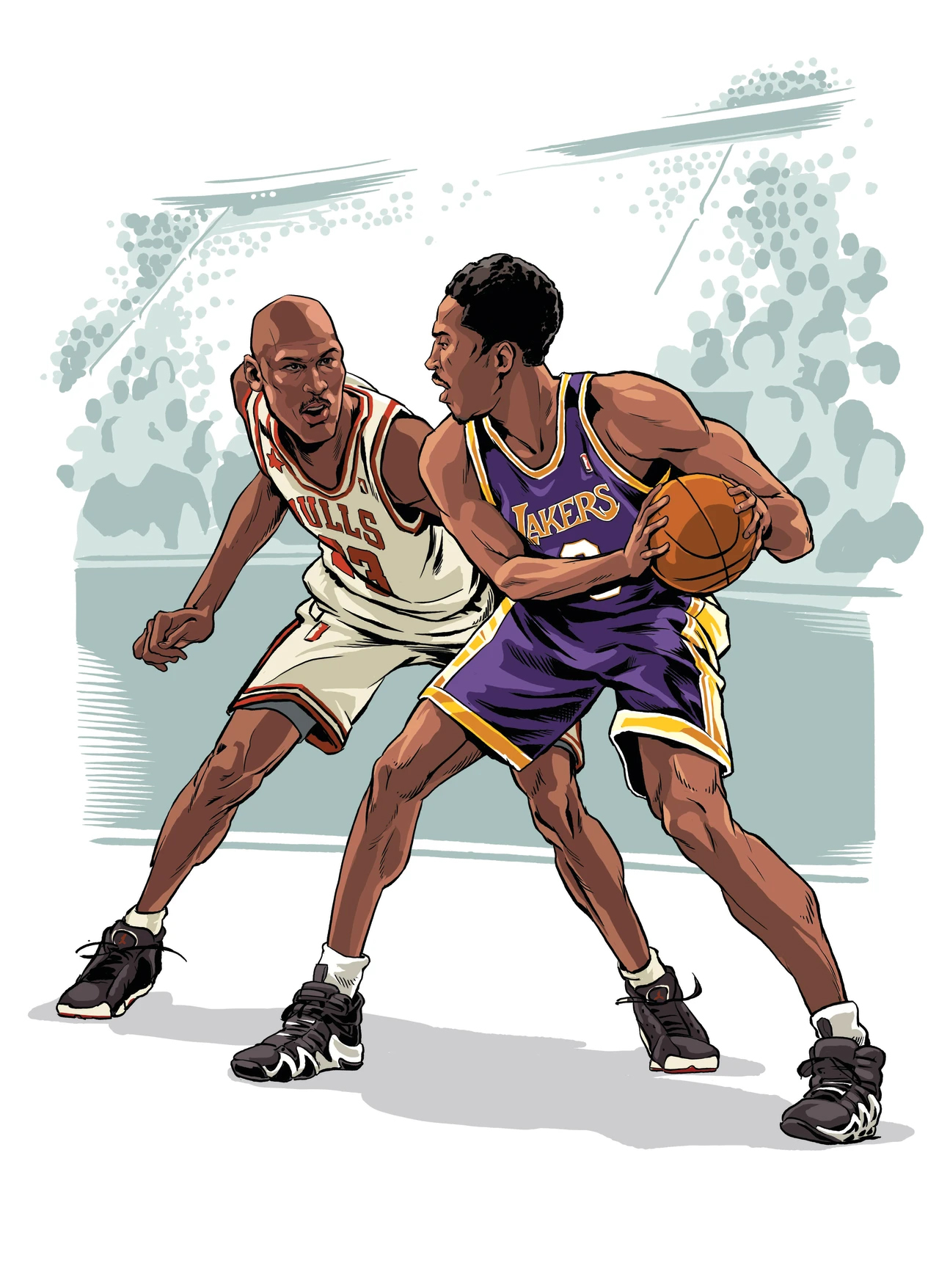
10. Chapter 10: Great vs. Great (Vs. Jordan)
Many players have buckled under the pressure of being labeled the “next Michael Jordan." There was “Baby Jordan” Harold Miner, “French Jordan” Mickael Pietrus and “The Michael Jordan of Turkey” Hedo Turkoglu. Even DeShawn Stevenson was famously compared to Jordan by a scouting website when he jumped to the NBA directly from high school. Being the heir to Jordan’s throne was an impossible billing to live up to, but Bryant welcomed the comparison with open arms. In fact, Bryant didn’t aim to be the next Jordan — he wanted to be himself, a player he believed would someday be better than Jordan.
It's not often that two greats from different eras have the opportunity to go head-to-head, but because Bryant debuted in the NBA at such a young age and Jordan extended his career, Bryant and Jordan played each other in eight regular season games and three All-Star games. Bryant hadn't yet entered his prime and Jordan was out of his, but the results of their meetings paint a picture of two players who were eerily similar to each other.
Their first encounters took place during the 1996-97 season. Bryant was still a rookie learning as a reserve, while Jordan was still in the midst of his MVP and title runs. Jordan owned the early part of the "rivalry," but it didn't take long for the tide to turn. Still not a starter in his second season, Bryant used games against Jordan and the Bulls to show exactly why he was the Lakers' star of the future. The teams split the season series, and Jordan outscored Bryant in both games, but the margin started to close.
Even off the bench, Bryant's electric style of play and popularity in the NBA's most marketable city earned him a trip to the 1998 All-Star Game as a starter. In the first real Bryant vs. Jordan matchup, Bryant was the high scorer for the Western Conference, while Jordan took home MVP honors for a victorious Eastern Conference.
That appeared to be the end of Bryant vs. Jordan matchups until Jordan decided to return as a member of the Washington Wizards in 2001. By then, Bryant was a champion and full-fledged star and Jordan wasn't quite himself at the age of 38. Reversing his fortune against Jordan, Bryant dominated this phase of their matchups. Playing their final game against one another in March 2003, Bryant scored 55 points on Jordan, the most by either player in their head-to-heads.
The final chapter of the Bryant vs. Jordan story was written in December 2014, when Bryant passed Jordan for third place on the NBA's all-time scoring list. Nike commemorated his achievement with a special “Mamba Moment” NIKEiD design option for the Kobe 9 Elite Low — the very shoe he wore in the game. What the milestone says about the two players will forever be debated, and while Bryant envisioned himself becoming a better player than Jordan, he'd later acknowledge that just being in the conversation is satisfying enough. In the end, Bryant bucked the odds and became the closest player to Jordan since Jordan himself.

